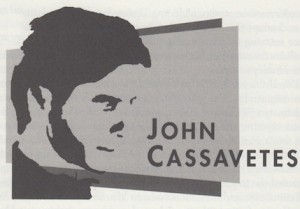Born: December 9, 1929, New York, NY
Died: February 3, 1989, Los Angeles, CA
He was a maverick every time he stepped behind the camera.
—Michael Barson
John Cassavetes was a television writer whose raw style was in demand in the untamed environment of TV’s golden age. His angry, emotional teleplays gave birth to the kind of live-wire performances that kept families glued to their couches and kept movie theater owners fretting over the powerful lure of home entertainment. Cassavetes was also a skilled actor and director who had worked on more than eight film and television projects before a startling performance with Sidney Poitier in Martin Ritt’s interracial tale Edge of the City (1957) threw him into the spotlight, where he would remain for thirty-five years. He was a double threat—an actor whose sheer intensity would foreshadow such seventies superstars as Al Pacino and Robert De Niro, and a fiercely original director who would become a hero of the burgeoning independent film industry in America.
Taking to the streets of New York with a 16mm black-and-white camera, Cassavetes began making features with Shadows (1959) and launched a different style of American film. Harkening to the cinema verité of the French New Wave, he brought the method actor’s perspective to the director’s chair. Despite working from a detailed script, Cassavetes relied heavily on improvisation, so that the story’s strength emanated from an analysis of the characters. On his sets, crews were instructed to follow the whims of the actors, even if this meant traveling over electrical cords and around corners. This free-wheeling method often required the use of hand-held cameras, which gave many shots an erratic feel. Shadows was an instant classic even before it captured the Critics Award at the 1960 Venice Film Festival, and its realistic quality would influence many New York City “street” films of the following decade, most notably William Friedkin’s The French Connection (1971) and Martin Scorsese’s Mean Streets (1973).
After directing a pair of studio-financed flops, Cassavetes vowed to make movies on his own terms. Paying for his personal projects by taking acting assignments on commercial films, including The Dirty Dozen (1967) and Rosemary’s Baby (1968), he returned to independent productions with Faces (1968), a film mostly seen in small venues. Slowly, Cassavetes was building a reputation as an uncompromising artist with a unique gift for storytelling. Actors, particularly those who practiced the Stanislavsky method, were eager to work with him—even without pay. Many actors even also pitched in with set, costumes and promotional efforts.
Husbands (1970) gave him the chance to be on both sides of the camera, and his growing respect and popularity made acting in mainstream Hollywood movies unnecessary. His steady output of independent work began paying for itself, and John Cassavetes continued to add new dynamics to his films. Minnie and Moskowitz (1971) and A Woman Under the Influence (1974) both included Cassavetes’s wife, Gena Rowlands, among a group of distinguished actors. The ensemble casting was powerfully effective, and Robert Altman and Woody Allen adopted it almost exclusively in their subsequent pictures.
Cassavetes’s trademark style was cause for some confusion. He became so identified with the improvisational method that his roles in films like Elaine May’s Mikey and Nicky (1976) and Paul Mazursky’s Tempest (1982), which were made with the free-form approach, were often mistaken as Cassavetes’s own directorial efforts.
Wider audiences enjoyed Cassavetes’s The Killing of a Chinese Bookie (1976), a gritty film about a Los Angeles nightclub owner who has to kill a bookmaker to repay a mob loan. In art houses, he gained an underground following that blossomed into cult status, and the arrival of videocassette rentals helped get his work in front of film students and critics, who rediscovered his impressive career after his death in 1989. Following the family tradition, director Nick Cassavetes would later adapt one of his father’s unfinished scripts into She’s So Lovely (1997), starring Sean Penn, and remake a version of The Killing of a Chinese Bookie.
Before his untimely death, Cassavetes’s unique style was an institution. He was less interested in creating films with commercial appeal than in capturing something raw and immediate. He aspired to nothing more than putting two characters in a close space and leaving them to sort through an emotional puzzle while a nearby camera watched patiently for something to happen. By placing character exploration ahead of traditional storylines, his focus on interaction and relationships enhanced the artistry of film. In word and deed, he represented the spirit of the modern independent filmmaker, embracing the notion that the process of making movies was an opportunity for discovery. By avoiding the conventional, Cassavetes blazed a refreshingly new path nearly a hundred years after the advent of moving images, and a new wave of documentarists and feature film directors picked up their cameras and followed.
To read all the republished articles from ‘The Film 100,’ as well as the complete list of 100 most influential people in the history of the movies, go to Reintroducing the Film 100 here on Keyframe.





